
OKLAHOMA CITY — A 30-foot boat drifted through the air of Military Park, as two construction vehicles lowered it into place. Onlookers stopped to watch the operation.
A woman walking by asked another passerby about the boat, its hull curved like a crescent moon and painted with several symbols: a gliding koi, a crane in mid-flight, a lone fisherman casting his line.
Neither knew why a boat sculpture was being installed in a landlocked state.
“Let’s go find out,” one said.
The new art installation in the heart of Oklahoma City’s Asian District marks the 50th anniversary of the fall of Saigon by communist North Vietnamese forces, effectively ending the Vietnam War. The boat, anchored in the “Vietnamese heart” of the city, commemorates the escape that hundreds of thousands made after the war.
Benches are built into the center of the boat, shaded by a small overhang, inviting passersby to sit, pause and listen.
For artist Denise Duong, the project she took on with Gabriel Friedman, her partner and father of their two daughters, was a personal one. Her family also fled on boats to build new lives in the American heartland.
The hull features symbols drawn from Vietnamese folklore. A lotus represents good fortune, while a turtle represents longevity. On the head of the boat is a crane to help guide the way. When deciding what symbols to paint on the boat, she steered away from any that would be too graphic or portrayed the horrors so many faced.
“It was very dreary and scary for them,” Duong said of her family members and the journey they took. “But they knew if they made it through this, they would be prosperous and have a good life and filled with the love that they wanted for their family.”
Friedman, who worked with Duong on the art piece for the past two years, said the boat is a “vessel for freedom” because for many who fled there was no other way out.
The Asian District in Oklahoma City was born from the refugees who resettled in the area with help from several charities. The district is known for its many restaurants, bakeries and other businesses, many Asian American-owned or operated.
More than 13 million people visit the Asian District each year, more than 4 million of them first-time visitors, according to the Oklahoma City Chamber of Commerce.

Members of Oklahoma’s Vietnamese American community prepare for the ribbon cutting of the art installation, “We Have Arrived,” which is a replica of boat used to escape Vietnam after the fall of Saigon in 1975. Photo By Adam Kemp/PBS News
Thuan Nguyen, president of the Vietnamese American Heritage Community of Oklahoma, was 4 years old when he and his mother fled Vietnam by boat.
Nguyen said he was forced to leave his father, brother and sister behind as he and his mother made the journey first to Indonesia before getting a sponsorship to come to America and ultimately to Oklahoma City.
In honor of the journey and the community Vietnamese Americans built in Oklahoma City, Nguyen said his organization decided to name the new art installation, “We Have Arrived.”
“After the fall of Saigon, millions fled Vietnam,” Nguyen said. “I’m part of that history. The people that made it here, they were pioneers. We took that journey not knowing if we were going to see tomorrow.”
Nguyen is reminded each April of the hardships his family went through to make it to the U.S. Whenever he walks around the Asian District and sees all the local businesses, he’s filled with pride.
He wants that pride to be part of the story shared within the boat and surrounding benches.
“We don’t want to hang on to the hurt, the sadness and the heartache,” Nguyen said. “We want to move forward from here and the way we do, is with that symbol of our boat,” which carries resilience, hope, love, compassion and forgiveness, he added.
For the Rev. Viet Nguyen, the boat looks familiar.
As a teenager in Vietnam, Nguyen worked on a fishing boat. The design of the sculpture is based on a photo he had of that boat.
After the communist regime seized control of the country in 1975, Nguyen remembers bombings and people lying dead in the streets. Nguyen and 26 of his family members decided to flee by boat. It normally carried just 10 people.
“Everyone was trying to get out,” he said. “This little boat was our only way.”
They sailed into the ocean without a destination, praying that a passing cargo ship would rescue them before they died of dehydration, starvation or succumb to rough seas.
After five days adrift, a Panamanian cargo ship traveling to Singapore appeared. The wife of the captain spotted a young baby on the fishing vessel, Nguyen’s infant nephew, and begged her husband to turn around. Nguyen’s family were saved from the seas, but faced several years of homelessness, living in refugee camps in Malaysia and Indonesia.
By 1980, Nguyen made it to America. Today, he leads a congregation of hundreds as the senior pastor of St. Andrew Dung-Lac, a Vietnamese Catholic parish in Oklahoma City.
Nguyen said he hopes he’s making good on his prayers from his time on the boat.
“I am so blessed,” he said. “Every mass, I say a prayer for the people of Panama. … I say a prayer for all the people who helped us along the way.”
The 50th anniversary comes as America is reshaping its stance on immigration and refugees. The Trump administration has reportedly ordered U.S. diplomats in Vietnam to refrain from participating in ceremonies commemorating the 50th anniversary of the fall of Saigon this week.
Citing four unnamed American officials, The New York Times reported that senior diplomats, including Marc Knapper, the U.S. Ambassador to Vietnam, were told to avoid any events connected to the April 30 observance.
The Trump administration paused the processing of some green card applications, in a bid to tighten vetting procedures for immigrants, including refugees who were forced to flee their homes.
Bill Frelick, director of refugee and migrant rights division for Human Rights Watch, wrote that Trump’s anti-immigrant policies are a signal that the U.S. is closing the door to decadeslong partnerships with faith-based groups to “welcome newcomers and enrich the country.”
“What happens in the absence of safe, orderly, and lawful pathways?” Frelick wrote days after Trump’s slew of executive orders that claimed there was an “invasion” at the U.S. southern border. “If these orders stand, the world will certainly become a more dangerous, less humane place for everybody.”

Artist Denise Duong and her daughter watch as the boat replica is placed on its frame in Oklahoma City’s Military Park. Photo by Adam Kemp/PBS News
On the day the boat was fixed into place, Duong’s young daughter climbed onto its wooden benches and leaned over the side to look at her mother’s artwork.
Her parents explained what some of the symbols meant, like the phoenix rising, representing grace, virtue and rebirth.
That’s the primary purpose of the boat. To teach these lessons so they won’t drift away.
Insightful, trustworthy journalism, for everyone.
Your tax-deductible donation ensures our vital reporting continues to thrive. Support PBS News Hour now.
















































